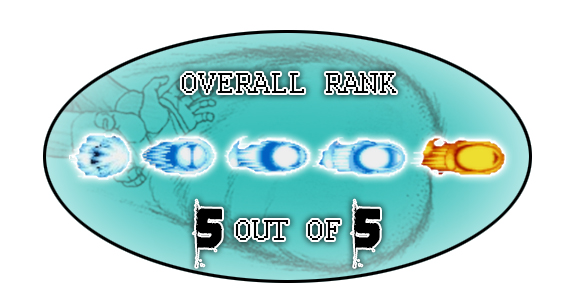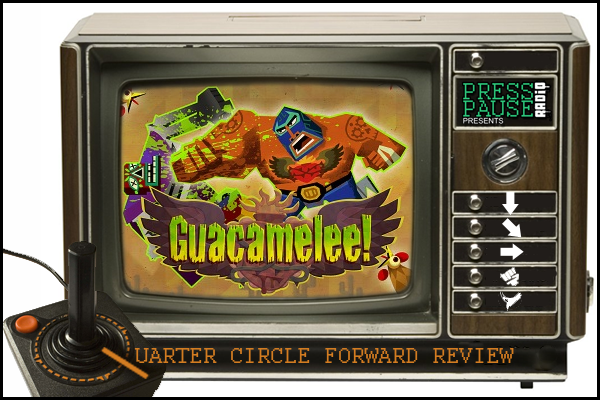
 very culture possesses a title of incredible significance, one that grants the individual who bears it fame and the opportunity to leave behind a legacy for those who succeed said title; the proud lineage of the luchador is such a title. Majestic forces of strength in the ring, these masked heroes symbolize the principals and codes of virtue as they launch from colorful ropes and transform into deadly flying emissaries of justice against their opponents—Lucha libre is storied lifestyle and that’s what Drinkbox Studios’ Guacamelee aims to deliver, and it does just that, and surprisingly more.
very culture possesses a title of incredible significance, one that grants the individual who bears it fame and the opportunity to leave behind a legacy for those who succeed said title; the proud lineage of the luchador is such a title. Majestic forces of strength in the ring, these masked heroes symbolize the principals and codes of virtue as they launch from colorful ropes and transform into deadly flying emissaries of justice against their opponents—Lucha libre is storied lifestyle and that’s what Drinkbox Studios’ Guacamelee aims to deliver, and it does just that, and surprisingly more.
See, while some are already dubbing the underrated indie studio’s latest “Mexicovania,” the sub-genre’s formula and direction has suffered from some real stinkers. Other contemporaries before it have saturated the market, leaving the core mechanic dangerously leaning towards near-stagnation. Seconds into Guacamelee, however, will have you forgetting all of that, as it manages to not only bring back the gameplay style to true form, but goes a step further to set a completely new standard for the formula to follow for years to come.
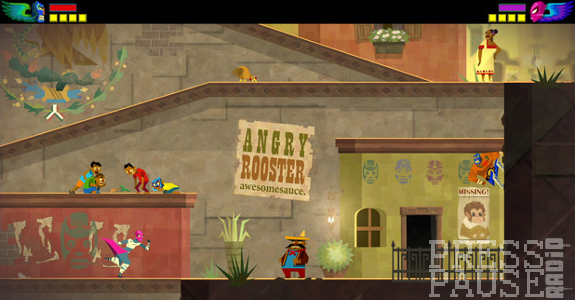
So that’s a lofty statement right? You know, that part where I mentioned that Guacamelee sets a bar above what is essentially a fairly binary set of dynamics to a formula that’s solely distinguished through its presentation and aesthetic? Guacamelee achieves this recognition by not only excelling the presentation aspect and in spades no less, but the title ups the ante by innovating upon the “Metroidvania” foundation.
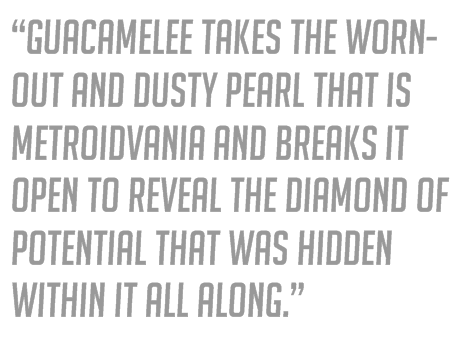 It all starts with a man who has always wanted a little more, Juan Augacate. The poor farmer of this story heads towards the preparations of his villiage’s festival, and as he is approached by the love of his life, El Presidente’s daughter, the situation starts going to hell quite literally—thanks to a mal esqueleto (that’s Spanish for "evil skeleton" because learning is fun) that arrives to wreak havoc. Juan is comically murdered soon after, and is introduced to the world of the dead where he soon becomes the heroic luchador he was destined to be.
It all starts with a man who has always wanted a little more, Juan Augacate. The poor farmer of this story heads towards the preparations of his villiage’s festival, and as he is approached by the love of his life, El Presidente’s daughter, the situation starts going to hell quite literally—thanks to a mal esqueleto (that’s Spanish for "evil skeleton" because learning is fun) that arrives to wreak havoc. Juan is comically murdered soon after, and is introduced to the world of the dead where he soon becomes the heroic luchador he was destined to be.
The narrative keeps up this light yet black comedic tone from beginning to end, and Guacamelee hits all the marks for charm and whimsy. As you begin traversing the initial levels of the game, Gucamelee nails level design to a tee—areas are simple where needed, and complex in all aspects that construct the core of the level.
Each facet of an area has intentional design choices, and the bright Mexican styled aesthetic works to visually identify with players right away in order to create a relation towards navigation. No one area is alike. To clarify, this isn’t in the sense in where these visual cues of the level indicate that the player needs to “double-jump” there just because of the suggestive architecture of the level design, but because it’s the place in the village that had a little girl with a missing doll, or the missing mariachi who’s being mourned over from his sentimental compadres.
Gucamelee’s personality stands as a fundamental mechanic, something that isn’t really seen in a lot of games that don’t have "Super Mario Bros." in the title. Where the world feels alive because of the authentic Mexican art direction, the advancement is handled with the same organic mindset.
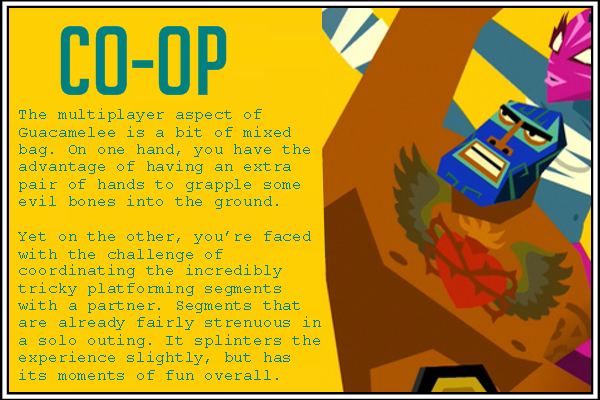 The dichotomy of the barriers for entry within the world of Guacamelee is simple in concept and brilliant in design. Areas will be blocked off by various colors, where red will require Juan’s Rooster Uppercut or Green requiring the Frog splash. Each block is both apparent and identifiable, which enforces the already established philosophy of aesthetically-driven navigational design. Remember when I mentioned the land of the dead? Using the dynamic of paralleling reminiscent of Link to The Past, you’ll need to constantly switch dimensions back and forth in order to navigate in areas in where the landscape alters based in which reality you’re in. Combining this dynamic with the established fundamentals of Metroidvania design even allows for a condensed map to feel expansive without ever feeling tedious, and that’s the beauty of Guacamelee’s design. Exploration is not only bolstered, but platforming reaches levels of 8-bit inspired masochism, and yet still has an array of elegance because the intentional design around Juan’s responsive abilities. Dashing from walls, switching back and forth between the land of the dead and the living, and double jumping 'till you die begins resonating deeper with your fingers in each new area; it consistently changes up and you’re never far behind with all the changes.
The dichotomy of the barriers for entry within the world of Guacamelee is simple in concept and brilliant in design. Areas will be blocked off by various colors, where red will require Juan’s Rooster Uppercut or Green requiring the Frog splash. Each block is both apparent and identifiable, which enforces the already established philosophy of aesthetically-driven navigational design. Remember when I mentioned the land of the dead? Using the dynamic of paralleling reminiscent of Link to The Past, you’ll need to constantly switch dimensions back and forth in order to navigate in areas in where the landscape alters based in which reality you’re in. Combining this dynamic with the established fundamentals of Metroidvania design even allows for a condensed map to feel expansive without ever feeling tedious, and that’s the beauty of Guacamelee’s design. Exploration is not only bolstered, but platforming reaches levels of 8-bit inspired masochism, and yet still has an array of elegance because the intentional design around Juan’s responsive abilities. Dashing from walls, switching back and forth between the land of the dead and the living, and double jumping 'till you die begins resonating deeper with your fingers in each new area; it consistently changes up and you’re never far behind with all the changes.
Guacamelee isn’t just all run-and-jump, as it places heavy emphasis on combat; all of those traversal abilities I mentioned earlier are wrestling moves... naturally, right?
Throughout the stages, you encounter enemy mob challenges within an arena environment, or just clusters of enemies in general, and you’ll be jumping from left to right to juggle between them all. The physics behind Juan’s combination attacks all have the same level of intentional design along with the different nuance tactics of "which combo is effective against which enemy." The resulting response is immaculate, and could even be considered on par with the likes of Super Smash Bros. Juan can also grapple enemies into throws and slams used to chain other attacks, including the special abilities, unearthing a surprising amount of depth.
Different poncho-covered skeletons and other various enemies will not only have different tactics central to them that you identify by color, but at times they also have shields that only yield to the right special attack, which is distinguished from its color (more of that marvelously effective intentional design again). Even different mobs in different realities will have to be switched back and forth before you can send the haunted bones back to hell in a completely satisfying and frenetic display of 2D combat that warrants the aforementioned comparison.
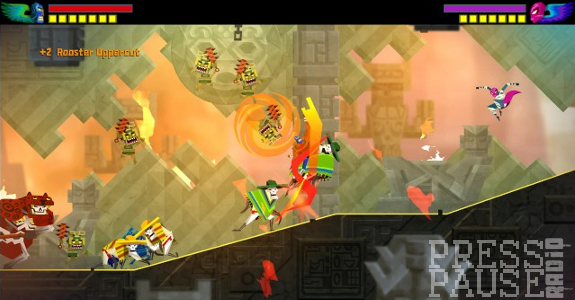
The graphics the culture attributes to the game deliver a genuine justice to its articulation, and are a marvel to witness in motion as colors and shapes weave together and interpret the many facets of Mexican culture into a bright and vivid display of colors and art. The sense of humor in Guacamele homages everything from the internet super stars Business Cat and Rape Wolf to the games it directly lifts liberties from, including Super Mario Bros. and The Legend of Zelda, and it all works into the cheeky theme that Gucamelee is trying to sell us. The exchange of dialogue between characters and NPCs has this blatant facetiousness in its referential humor that carries punch lines like Family guy, and yet brazenly includes the cheap visual gag or two, because it all works to the whimsy that makes the presentation of Guacamelee enjoyable.
Guacamelee takes the worn-out and dusty pearl that is Metroidvania and breaks it open to reveal the diamond of potential that was hidden within it all along. Regardless of which format you choose to dive into the ring with, Guacamelee is a must-own game and testament that Drinkbox Studios will continue to be an asset to Sony in the years to come.
